“The TV show Firefly is a big inspiration for us,” Dreadnought project director Peter Holzapfel was saying to me recently during a San Francisco preview event. “So is Sid Meier’s Pirates.” And then, for just a moment, that ceased to matter as a ship ten times the size of mine warped right in front of me.
Dreadnought is the latest game from Yager, the studio that created fantastic (well, storywise, anyway) violence-critiquing shooter Spec Ops: The Line — and, long before that, a cult hit space ship game called, er, Yager. Dreadnought is, first and foremost, a team-based combat game about massive spaceships — think Star Destroyers from Star Wars or Battlestars from Battlestar Galactica rather than X-Wings — that move slowly but pack a tremendous punch. Yager, however, also wants it to be more than that. A whole lot more.
That starts with a singleplayer mode that’s getting just as much focus as Dreadnought‘s previously revealed team-based multiplayer.
“We liked doing Spec Ops, but that story is finished,” said Holzapfel. “Doing another Spec Ops would be kinda tricky to pull off. With this we wanted to create a universe that can do a lot of things.”
Citing influences ranging from Firefly to Sid Meier’s Pirates to Mass Effect, Holzapfel unfurled his studio’s plan for an episodic storyline involving militaries and roguish space scoundrels. In between episodes, however, you can just explore space, going through planet after planet with a fine-toothed comb — or a hulking monstership that’s basically made of nuclear warheads, as it were.
“There are two parts to it: one will be the episodic approach. That actually has a directed story and everything like that. We don’t know exactly how often episodes will release yet, but [it will be like a TV season].
“But apart from playing the episodes you can also roam around this… well, actually universe is a bit misleading because we’re starting in our solar system. We want to be relatable in the beginning and then expand into crazier stuff later.”
“We want that part to be like Sid Meier’s Pirates,” he added, referencing the classic seafaring game’s focus on free-spirited exploration and building up a crew. Your crew will function as both your loadout of skills/perks and on board personalities. They will banter, they will critique your battle strategies.
Behind all of this is some high level writing talent, as well.
“We wanted to do something different, but we know people expect a good story from us after Spec Ops,” said Holzapfel. “We’ve got multiple writers including Dan Abnett, who co-wrote what eventually became a Guardians of the Galaxy series.”
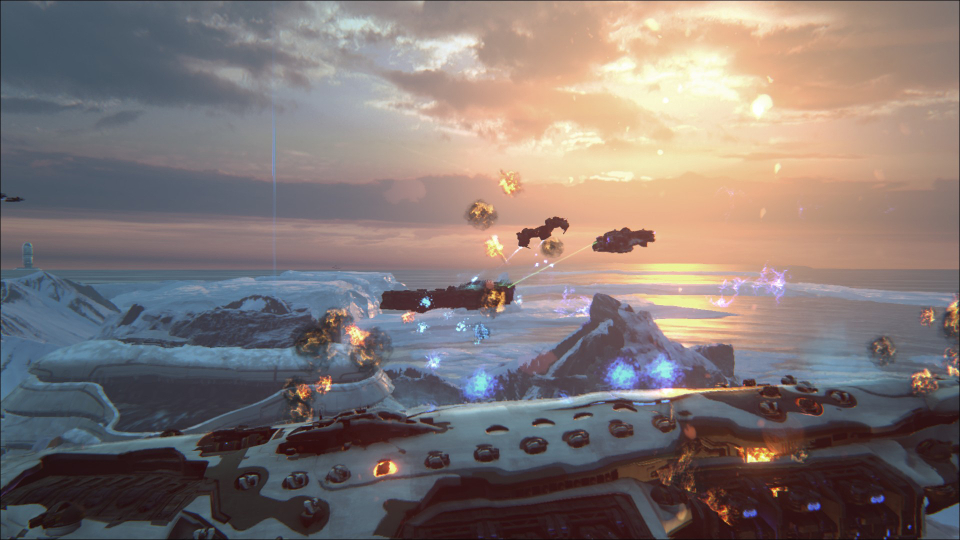
“We’re going for a universe that’s kinda like Firefly — more about grey zones than good and evil. It’s faction-based, and those factions have different alliances. The way those play out affects the player. So you’re not there to save everything. You’re part of a universe where bigger things are going on. There are the wild outskirts of the universe, and then there’s the center where everything’s a bit more settled. It’s about colonial times, pushing boundaries. There’s a gold rush mood to it. Rules are still undefined.”
He added, however, that sci-fi is a powerful tool for abstracting and discussing current events. There’ll be plenty of that in Dreadnought as well, providing a thin line of heritage back to Spec Ops.
Flying Free
The truly nutty part? All of this will be free. And while there will of course be items to purchase with real world money (gotta keep the game afloat somehow), Holzapfel said he desperately wants to avoid selling players anything that impacts gameplay:
“Nothing’s set in stone, but right now we’re trying to design this in a Team Fortress 2 like way. There will be no power progression. The idea of ‘I pay for something and then I get a gameplay advantage’ is basically eliminated, because this is about diversity of weapons, not power. At the moment we’re talking about a way to detach gameplay from monetization completely.”
“We as a developer have a reputation, and we don’t want to fall into a trap of being mislabeled based on something we didn’t do years ago”
All of which sounds great on vague terms, but how will Dreadnought‘s stew of ideas and inspirations work in action? That’s the big question right now, not to mention the main source of my doubts about the game. Yager’s still getting its ducks (again, actually 500-ton murder canoes) in a row on that, but it’s important to keep in mind that — despite sky-high ambitions — this is only a 35-person team.
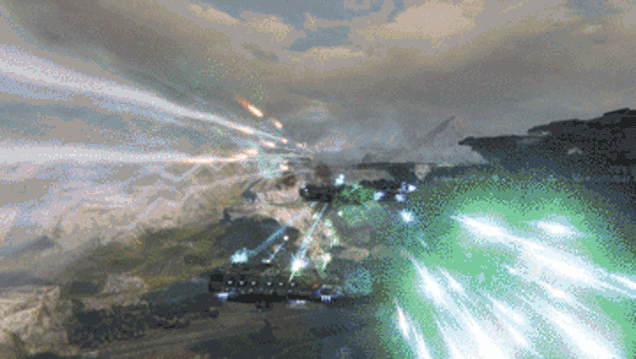
They would like to do Literally Everything, but the key is to do so economically. Maybe that will result in a leaner, tighter game, or maybe it will soar too close to the sun, falling short in the face of its own limitations. Holzapfel, to his credit, was realistic about the fact that his studio isn’t a triple-A juggernaut, that certain aspects of the game won’t have everything and the kitchen sink thrown in. Case in point:
“We want to do something like what The Walking Dead [game series from Telltale] has right now with our episodes, but we can’t really branch our story. If we were to do that and follow it through, the amount of different content we would have to create for everybody would go into insanity.”
“Really, though, a lot of The Walking Dead‘s choice is illusion. But there’s little things like how people react to you and your behaviours. That’s what we’d like to do.”
Limits versus ambitions. There’s a lot of room to fail here, but there’s also space for very big things.
Clash of the Titanics
For all of Dreadnought’s lofty goals, moment-to-moment play is actually relatively simple. You control your ship similar to how you’d manoeuvre a character in a first or third-person shooter: WASD for directions with the added twist of space bar and shift to control your altitude (up and down, respectively). Each ship class also has four abilities — mapped to the number keys — which you can customise.
These ships, though, are colossal creaking defiances of every last law of physics. All five classes (with the exception of the nimble Corvette) move slowly, deliberately — especially the Dreadnought itself, which almost seems to take ragged breaths as it lurches forward.
This is a game-changer.
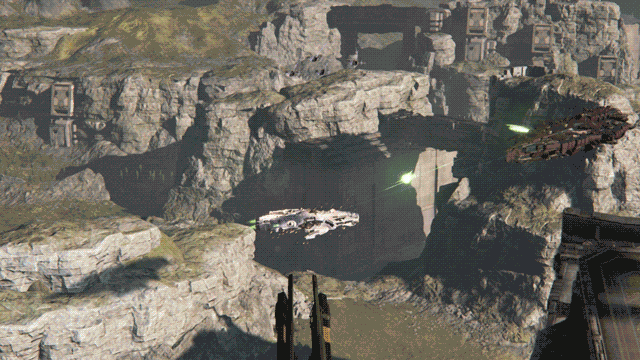
Ships are heavy but durable, and in my time playing team deathmatch (one of a few planned multiplayer modes), I found that smart positioning and teamwork were absolute musts. Some ships, like a long-range class that’s essentially a giant flying sniper rifle, were better suited to filling out a team’s back line while Dreadnoughts took the center with heal-beam-spouting support ships in tow. Corvettes, meanwhile, could take advantage of Dreadnoughts’ slowly-pirouetting turrets and swoop over/under them, pecking away at their shields and armour.
In practice, it all felt like something midway between World of Tanks‘ surprisingly agile pacing (given that it’s also about big lumbering machines) and a large-scale naval battle. As with non-space ships, bigger cannons in Dreadnought tended to fire from the side of ships, requiring even more deft timing and positioning.
Each ship really struck me as different, too — perhaps with the exception of the middle-of-the-road Destroyer, which didn’t do anything in particular spectacular fashion. Being a Dreadnought was empowering but fraught with peril. I was essentially a giant target, reliant on my teammates and whatever cover I could find that didn’t obscure my firing capabilities. Being a Corvette really put that in perspective, given that I quickly became the bane of Dreadnoughts’ existences. They couldn’t touch me, especially when I used a handy radial menu to divert power from shields and weapon-fire to speed and then — if that failed — used a quick teleport to blip out of range entirely.
Those sorts of dynamics — moments of tremendous empowerment despite a class’ glaring, nearly crippling weaknesses compared to others — defined multiplayer matches. It all felt good too — something I was initially concerned about given that Spec Ops was known for a lot of things, but great shooting wasn’t one of them.
Though multiplayer is currently a no-frills affair beyond typical XP-based progression and ship upgrades, Yager has big plans for that as well. Holzapfel said they’re hoping to unite single-player and multiplayer progression in some way or another, possibly with major story-based battles between episodes.
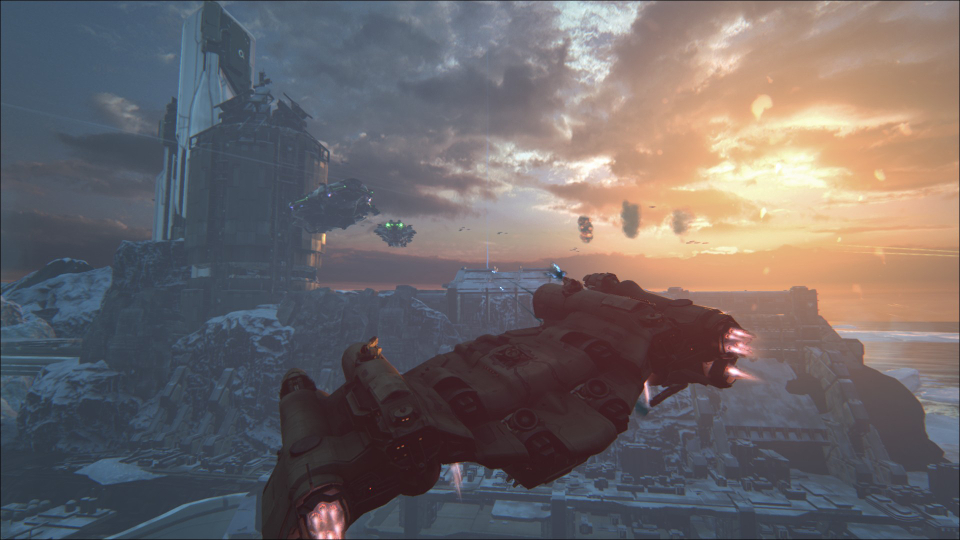
The team is also working on a mode where, if players bite the big one in combat, they will end up on allies’ ships. The hope is that this will eventually culminate in a glorious, teamwork-fuelled last stand — and maybe even an out-of-nowhere comeback. Again, though, Holzapfel admitted that his studio has to keep its limits in mind. The mode, then, might not function like you’d expect:
“We like the idea of all the hero captains fighting it out on one ship at the end — and potentially mounting a comeback. Having players manning different guns [on the same ship] is technically challenging, though. Right now it’s about battlefield awareness and multipliers if multiple people focus [their field of view] on the same ship.”
Huh. Sounds kinda… awkward.
I continue to worry, then, that Dreadnought may end up a victim of its own ambitions, a game that can’t quite pull off its coolest ideas and ends up landing somewhere in the empty, space-debris-strewn middle.
However, I can’t deny that what I played — while still very much in development — was already slick, interestingly balanced, and fun. Granted that was only multiplayer (single-player is still too early), but combat is the core of the game and it’s already strong. So worst case scenario, the game might end up kinda like the Serenity (from Firefly) itself: maybe she don’t look like much, but she’ll fool ya.
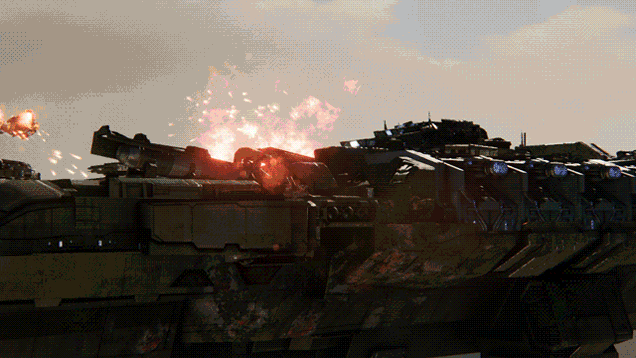
Comments
7 responses to “The Spaceship Game With Firefly-Sized Ambitions”
hmm may finally have to buy that gaming PC…
Living in a console shanty, eh?
I love the idea of what they’re doing. Having a hub world where players can explore and episodes for delivering a brilliant story sounds like a great bridge between games like Syndicate or Pirates!, where you can play for hours on end with no goal, and Mass Effect. Should give enough time to polish all the assets/story ideas that RPGs need and still be fun.
I’ve wanted to captain a capital ship in a game like this since the likes of Wing Commander and Freespace, so Dreadnought appeared to be a dream game until all I saw was PvP. If there’s going to be single player then it goes back on my radar for sure.
Star Citizen has a Single Player campaign of 50-70 missions.
So is the single player story actually single player? Like is it traditional single player with only you in the game ie offline, or “single player” where everyone’s on the same server but the story line is one player only?
My question too, it annoys me how developers have changed what they call Single Player these days. Playing by yourself on a multi player server is not single player, as far as I’m concerned.
Freespace 3, c’mon.